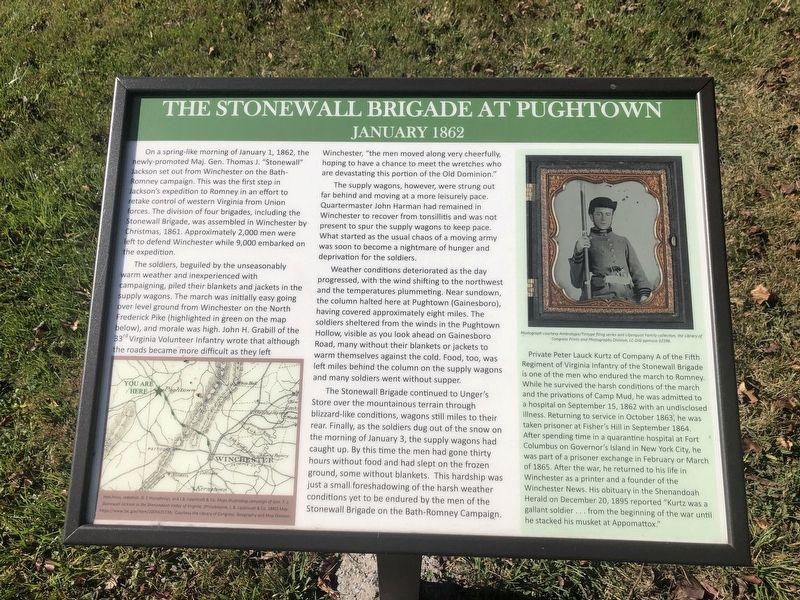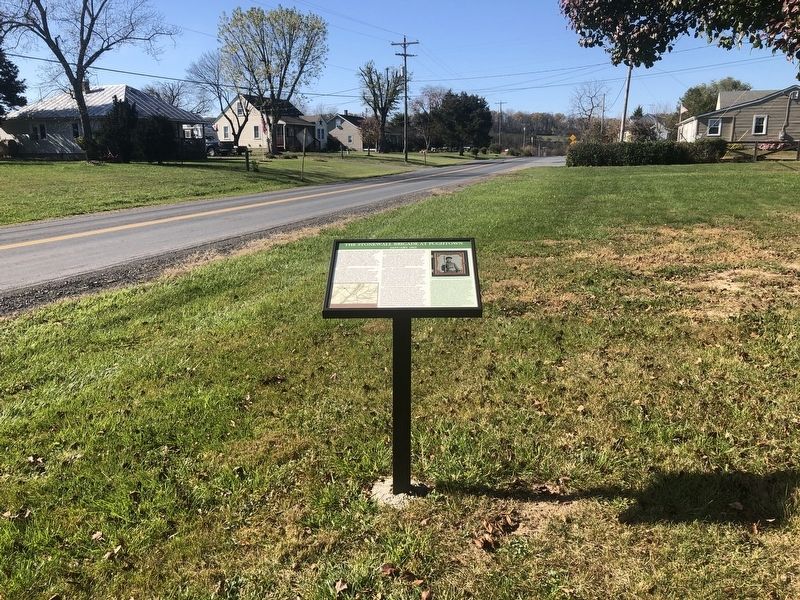Gainesboro in Frederick County, Virginia — The American South (Mid-Atlantic)
The Stonewall Brigade at Pughtown
January 1862

Photographed By Devry Becker Jones (CC0), November 6, 2020
1. The Stonewall Brigade at Pughtown Marker
On a spring-like morning of January 1, 1862, the newly-promoted Maj. Gen. Thomas J. "Stonewall" Jackson set out from Winchester on the Bath-Romney campaign. This was the first step in Jackson's expedition to Romney in an effort to retake control of western Virginia from Union forces. The division of four brigades, including the Stonewall Brigade, was assembled in Winchester by Christmas, 1861. Approximately 2,000 men were left to defend Winchester while 9,000 embarked on the expedition.
The soldiers, beguiled by the unseasonably warm weather and inexperienced with campaigning, piled their blankets and jackets in the supply wagons. The march was initially easy going over level ground from Winchester on the North Frederick Pike (highlighted in green on the map below), and morale was high. John H. Grabill of the 33rd Virginia Volunteer Infantry wrote that although the roads became more difficult as they left Winchester, "the men moved along very cheerfully, hoping to have a chance to meet the wretches who are devastating this portion of the Old Dominion."
The supply wagons, however, were strung out far behind and moving at a more leisurely pace. Quartermaster John Harman had remained in Winchester to recover from tonsillitis and was not present to spur the supply wagons to keep pace. What started as the usual chaos of a moving army was soon to become a nightmare of hunger and deprivation for the soldiers.
Weather conditions deteriorated as the day progressed, with the wind shifting to the northwest and the temperatures plummeting. Near sundown, the column halted here at Pughtown (Gainesboro), having covered approximately eight miles. The soldiers sheltered from the winds in the Pughtown Hollow, visible as you look ahead on Gainesboro Road, many without their blankets or jackets to warm themselves against the cold. Food, too, was left miles behind the column on the supply wagons and many soldiers went without supper.
The Stonewall Brigade continued to Unger's Store over the mountainous terrain through blizzard-like conditions, wagons still miles to their rear. Finally as the soldiers dug out of the snow on the morning of January 3, the supply wagons had caught up. By this time the men had gone thirty hours without food and had slept on the frozen ground, some without blankets. This hardship was just a small foreshadowing of the harsh weather conditions yet to be endured by the men of the Stonewall Brigade on the Bath-Romney Campaign.
[Sidebar:]
Private Peter Lauck Kurtz of Company A of the Fifth Regiment of Virginia Infantry of the Stonewall Brigade is one of the men who endured the march to Romney. While

Photographed By Devry Becker Jones (CC0), November 6, 2020
2. The Stonewall Brigade at Pughtown Marker
Topics. This historical marker is listed in these topic lists: Roads & Vehicles • Science & Medicine • War, US Civil. A significant historical date for this entry is January 1, 1862.
Location. 39° 16.41′ N, 78° 15.128′ W. Marker is in Gainesboro, Virginia, in Frederick County. Marker is on Gainesboro Road (Virginia Route 684) just west of North Frederick Pike (U.S. 522), on the right when traveling west. Touch for map. Marker is at or near this postal address: 128 Gainesboro Rd, Winchester VA 22603, United States of America. Touch for directions.
Other nearby markers. At least 8 other markers are within 7 miles of this marker, measured as the crow flies. Gainesboro (within shouting distance of this marker); Willow Shade (approx. 3.1 miles away); Jeremiah Smith Family Cemetery (approx. 3.4 miles away); Willa Cather Birthplace (approx. 3.9 miles away); Second Battle of Winchester (approx. 5.2 miles away); Old Stone Church at Greenspring (approx. 5.2 miles away); a different marker also named Second Battle of Winchester (approx. 6 miles away); Lord Fairfax (approx. 6˝ miles away).
Credits. This page was last revised on November 7, 2020. It was originally submitted on November 7, 2020, by Devry Becker Jones of Washington, District of Columbia. This page has been viewed 361 times since then and 68 times this year. Photos: 1, 2. submitted on November 7, 2020, by Devry Becker Jones of Washington, District of Columbia.